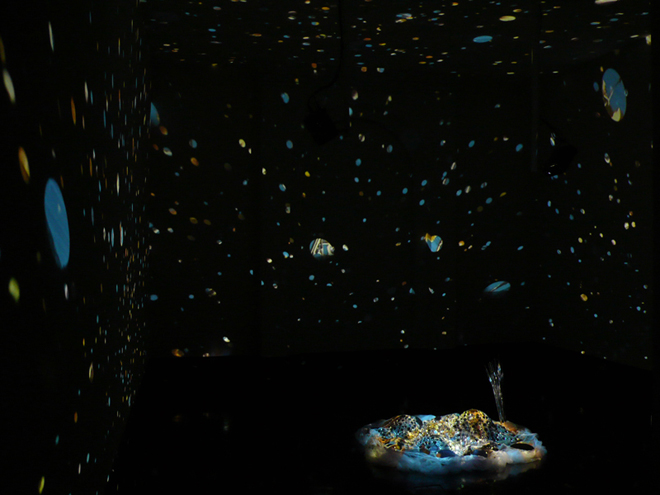Miniature and Massive: Shawn Hall’s “Pastoral Universe”
Brooke Sauvage pays a visit to the Ogden and reviews Shawn Hall's latest installation.

Installation view of Shawn Hall's "Pastoral Universe" on view at the Ogden Museum of Southern Art, New Orleans.
We ponder the infinitude of the stars but are unconcerned about the infinitude our papa has within him.
Milan Kundera, The Book of Laughter and Forgetting
Shawn Hall
Ogden Museum of Southern Art
925 Camp Street
August 2–November 2, 2014
In a world circumscribed by the tiny and tremendous, it can be difficult to find middling threads capable of rendering the vast cosmos comprehensible. Shawn Hall’s “Pastoral Universe,” a walk-through installation at the Ogden Museum of Southern Art, draws on this paradox of the very large and very small. Aligning these two extremes, Hall’s piece seems to ask: What’s at stake in our rapidly accelerating consumption of technology and how, if at all, might we mitigate the consequences on the natural world? Hall's answer seems to be: Just slow down.
A simple bench is the first signal that the artist intends for an immersive, contemplative experience. It is from this sedentary vantage point that the viewer awakens to the room and its contents.“Pastoral Universe” occupies a large, rectangular space, at the center of which is a decorative pile of mesh and mirrors roughly akin to the stump of a tree in size and shape. A canopy of overlapping projections stretches over the ceiling and walls, each portraying a looping image of the sun filtering through the branches of the tree. The room is actually empty save the makeshift stump and the bench but it feels full, bathed in the projections’ soft blue glow.
Although we receive the visual cues to a stump, branches, and leaves in the installation, the viewer is confronted most pointedly by a void—a complete lack of objects. What is taking up physical space merely looks like a tree. It is in these contrasts—emptiness and fullness, real and simulacrum—that the true work of Hall’s installation takes place. It is here that we are forced to think of our own bodies in relation to this world and all that is in it. Just as Milan Kundera marveled at the selfsame “infinitude” encompassed in the farthest reaches of the cosmos and within his father’s person, so too does Hall consider the universe from the microscopic and telescopic, challenging our oft-limited understanding of what is within and without ourselves.



